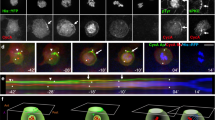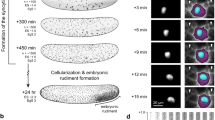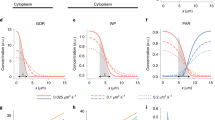Abstract
MANY theories have been advanced as to how the spore–stalk pattern of the slime mould Dictyostelium discoideum is established. Without exception these envisage the polarity of the grex stage of the life cycle as a key factor in specifying the pattern. One group of theories2–4 sees the combined influence of polarity and the grex tip as signalling positional information5,6 which determines that the front cells differentiate into prestalk cells and the back cells into prespore cells. An alternative view is that pattern formation occurs by sorting out within the grex of cell types which are pre-determined at an earlier stage of the life cycle7–11. Grex polarity is also a key factor in one suggested mechanism for sorting-out in that prestalk cells are seen as moving faster than prespore cells and therefore coming to the front of the migrating grex8,12. Because all these thories clearly suggest that pattern formation ought not to occur in circumstances in which the cell mass is unpolarised, we asked the question: ‘Is polarity necessary for differentiation and pattern formation in D. discoideum?’ We have found that a prestalk–prespore pattern very similar to that seen in the normal life cycle forms in spherical aggregates which, before pattern formation, have no detectable morphological polarity. We also describe the formation of unusual cyst-like structures from patterned spherical aggregates.
This is a preview of subscription content, access via your institution
Access options
Subscribe to this journal
Receive 51 print issues and online access
$199.00 per year
only $3.90 per issue
Buy this article
- Purchase on Springer Link
- Instant access to full article PDF
Prices may be subject to local taxes which are calculated during checkout
Similar content being viewed by others
References
Loomis, W. F., Dictyostelium discoideum—A Developmental System, (Academic, New York, 1975).
Rubin, J., and Robertson, A., J. Embryol, exp. Morph., 33, 227–241 (1975).
McMahon, D., Proc. natn. Acad. Sci. U.S.A., 70, 2396–2400 (1973).
Pan, P., Bonner, J. T., Wedner, H., and Parker, C., Proc. natn. Acad. Sci. U.S.A., 71, 1623–1625 (1974).
Wolpert, L., J. theor. Biol., 25, 1–47 (1969).
Farnsworth, P., and Wolpert, L., Nature, 231, 329–330 (1971).
Takeuchi, T., in Nucleic Acid Metabolism, Cell Differentiation and Cancer Growth (edit, by Cowdry, E. V., and Seno, S. ), 297–304, (Pergamon Oxford, 1969).
Bonner, J. T., Sieja, T. W., and Hall, E. M., J. embryol, exp. Morph., 25, 457–465 (1971).
Garrod, D. R., and Ashworth, J. M., Symp. Soc. gen. Microbiol., 23, 407–435 (1973).
Leach, C. K., Ashworth, J. M., and Garrod, D. R., J. Embryol., exp. Morph., 29, 647–661 (1973).
Maeda, Y., and Maeda, M., Expl Cell Res. 84, 88–94 (1974).
Garrod, D. R., Arch. Biol., 85, 7–31 (1974).
Swan, A. P., and Garrod, D. R., Expl Cell Res., 93, 479–484 (1975).
Gerisch, G., in Current Topics in Developmental Biology (edit, by Moscona, A. and Monroy, A.), 3, 157–197 (Academic, New York, 1968).
Takeuchi, L., Devi Biol., 8, 1–26 (1963).
Hohl, H. R., and Hamamoto, S. T., J. ultrastruct. Res., 26, 442–253 (1969).
Takeuchi, I., Aspects Cell molec. Physiol., 217–236 (1972).
Yu, N. Y., and Gregg, J. H., Devl Biol., 47, 310–318 (1975).
Newell, P. C., Longlands, M., and Sussman, M., J. molec. Biol., 58, 541–554 (1971).
Gerisch, G., Husler, D., Malchow, D., and Wick, U., Phil. Trans. R. Soc. Lond., B272, 181–192(1975).
Steinberg, M. S., in Cellular Membranes in Development (edit, by Locke, M.), 321–366 (Academic, New York, 1964).
Steinberg, M. S., J. exp. Zool., 173, 395–434 (1970).
Hayashi, M., and Takeuchi, L., Devi Biol., 50, 302–309 (1976).
Muller, U., and Hohl, H. R., Differentiation, 1, 267–276 (1973).
Bonner, J. T., and Slifkin, M. K., A. J. Bot., 36, 727–734 (1949).
Bonner, J. T., Ann. Nat., 86, 79–89 (1952).
Garrod, D. R. and Ashworth, J. M., J. Embryol. exp. Morph., 28, 463–479 (1972).
Watts, D. J. and Ashworth, J. M., Biochem. J., 119, 171–174 (1970).
Bonner, J. T., J. exp. Zool., 106, 1–26 (1947).
Sainte-Marie, G., J. histochem. Cytochem., 10, 250–256 (1962).
Author information
Authors and Affiliations
Rights and permissions
About this article
Cite this article
GARROD, D., FORMAN, D. Pattern formation in the absence of polarity in Dictyostelium discoideum. Nature 265, 144–146 (1977). https://doi.org/10.1038/265144a0
Received:
Accepted:
Published:
Issue Date:
DOI: https://doi.org/10.1038/265144a0
Comments
By submitting a comment you agree to abide by our Terms and Community Guidelines. If you find something abusive or that does not comply with our terms or guidelines please flag it as inappropriate.



